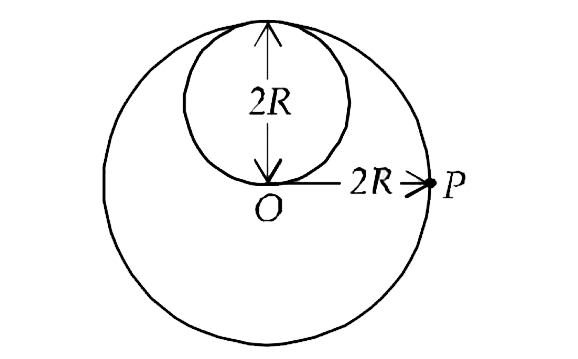An isotropic stationary source is emitting waves of frequency n and wind is blowing due north. An observer A is on north of the source while observer B is on south the source. IF both the observers are stationary, then
frequency received by A is greater than n
frequency received by B is less than n
freqeuency received by A equals to that received by B
frequencies received by A and B cannot be calculated unless velocity of waves in still air and velcity of wind are known
The correct Answer is:C
Since source and both the observer are stationary, therefore no change will be observed by the two observer. It means both the observers will receive waves with natural frequency, which is equal to n.
Topper's Solved these Questions
- SOUND WAVES AND DOPPLER EFFECTBook:CENGAGE PHYSICS ENGLISHChapter:SOUND WAVES AND DOPPLER EFFECTExercise:Multiple Correct
Explore 44 Videos
- SOUND WAVES AND DOPPLER EFFECTBook:CENGAGE PHYSICS ENGLISHChapter:SOUND WAVES AND DOPPLER EFFECTExercise:Assertion-Reasoning
Explore 24 Videos
- SOUND WAVES AND DOPPLER EFFECTBook:CENGAGE PHYSICS ENGLISHChapter:SOUND WAVES AND DOPPLER EFFECTExercise:Subjective
Explore 56 Videos
- RIGID BODY DYNAMICS 2Book:CENGAGE PHYSICS ENGLISHChapter:RIGID BODY DYNAMICS 2Exercise:Interger
Explore 2 Videos
- SUPERPOSITION AND STANDING WAVESBook:CENGAGE PHYSICS ENGLISHChapter:SUPERPOSITION AND STANDING WAVESExercise:Comprehension Type
Explore 5 Videos
Similar Questions
Which of the following statements are incorrect?
View SolutionStatement I: A tuning fork is considered as a source of an acoustic wave of a single frequency as marked on its body. Statement II: The tuning fork cannot produce any of its harmonics due to its special nature of construction.
View SolutionIn a car race sound signals emitted by two cars are detected by the detector on the straight track at the end point of the race. Frequency observer is 330 Hz and 360 Hz and the original frequency is 300 Hz of both cars. Race ends with the separation of 100 m between the cars. Assume both cars move with constant velocity and velocity of sound is 330ms. Find the time taken by wining car.
View SolutionA lamina is made by removing a small disc of diameter 2R from a bigger disc of uniform mass density and radius 2R, as shown in the figure. The moment of inertia of this lamina about axes passing though O and P is IOandIP respectively. Both these axes are perpendicular to the plane of the lamina. The ratio IPIO is

View SolutionA string of length L, fixed at its both ends is vibrating in its 1st overtone mode. Consider two elements of the string of the same small length at positions l1=0.2Landl2=0.45L from one end.
If K1andK2 are their respective maximum kinetic energies,then
View SolutionStationary Source And Moving Observer
View SolutionA source is moving with constant speed upsilon_(s) = 20 m//s towards a stationary observer due east of the source. Wind is blowing at the speed of 20 m//s at 60^(@) north of east. The source has frequency 500 H_(Z) . Speed of sound = 300 m//s . The frequency resgistered by the observer is approximately
View SolutionA stationary source emits sound of frequency
υ=1200Hz. If a wind blows at the speed of 0.1c deduce (i) the percentage change in the wavelength and (ii) the change in the frequency for a stationary observer on the wind side of the source. What happens when there is no wind, but the observer moves at speed 0.1c towards the source?
View SolutionAn isotropic stationary source is emitting waves of frequency n and wind is blowing due north. An observer A is on north of the source while observer B is on south the source. IF both the observers are stationary, then
View SolutionAn observer starts moving with uniform acceleration a towards a stationary sound source emitting a whistle of frequency n . As the observer approaches source, the apparent frequency, head by the observer varies with time as
View SolutionS1: Source and observer both are stationary and wind is blowing in a direction from source to observer then observer detects an apparent increases in frequency.
S2: Beat frequency is defined as the difference of frequency of two sources.
S3: Pressure node is always a displacement node and pressure antinode is always a displacement antinode.
View SolutionA stationary source emits sound of frequency 1200 Hz. If would blows at the speed of 0.1 v. deduce (a) The change in the frequency for a stationary observer on the wind side of the source (b) Report the calculations for the case when there is no wind but the observer moves at 0.1 v speed towards the source (Given : velocity of sound = v)
View Solutionएक स्थिर प्रेक्षक के सापेक्ष स्रोत को किस वेग से गति करनी चाहिए जिससे स्थिर प्रेक्षक द्वारा नापी गई आवृत्ति मूल आवृत्ति की आधी हों?
View SolutionAn observer and source are approaching one another with a relative velocity of 50 m/s. If the true frequency of the source is 1000 Hz, determine the observed frequency when
(i) Observer is stationary
(ii) Source is stationary
View SolutionS1: Source and observer both are stationary and wind is blowing in a direction from source to observer then observer detects an apparent increase in frequency.
S2: Beat frequency is defined as the difference of frequency of two sources.
S3: Pressure node is always a displacement node and pressure antinode is always a displacement antinode.
View SolutionObtain the equation of frequency observed by stationary observer and moving source.
View Solution
